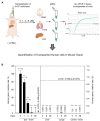Preclinical Study on Biodistribution of Mesenchymal Stem Cells after Local Transplantation into the Brain
- PMID: 37643762
- PMCID: PMC10686801
- DOI: 10.15283/ijsc23062
Preclinical Study on Biodistribution of Mesenchymal Stem Cells after Local Transplantation into the Brain
Abstract
Therapeutic efficacy of mesenchymal stem cells (MSCs) is determined by biodistribution and engraftment in vivo. Compared to intravenous infusion, biodistribution of locally transplanted MSCs are partially understood. Here, we performed a pharmacokinetics (PK) study of MSCs after local transplantation. We grafted human MSCs into the brains of immune-compromised nude mice. Then we extracted genomic DNA from brains, lungs, and livers after transplantation over a month. Using quantitative polymerase chain reaction with human Alu-specific primers, we analyzed biodistribution of the transplanted cells. To evaluate the role of residual immune response in the brain, MSCs expressing a cytosine deaminase (MSCs/CD) were used to ablate resident immune cells at the injection site. The majority of the Alu signals mostly remained at the injection site and decreased over a week, finally becoming undetectable after one month. Negligible signals were transiently detected in the lung and liver during the first week. Suppression of Iba1-positive microglia in the vicinity of the injection site using MSCs/CD prolonged the presence of the Alu signals. After local transplantation in xenograft animal models, human MSCs remain predominantly near the injection site for limited time without disseminating to other organs. Transplantation of human MSCs can locally elicit an immune response in immune compromised animals, and suppressing resident immune cells can prolong the presence of transplanted cells. Our study provides valuable insights into the in vivo fate of locally transplanted stem cells and a local delivery is effective to achieve desired dosages for neurological diseases.
Keywords: Brain; Immune response; Mesenchymal stem cell; Pharmacokinetics; Real-time polymerase chain reaction; Transplantation.
Conflict of interest statement
NB, JHJ, DYC, and HSK are employees of and stock and/or option holders in CELLeBRAIN, Ltd.
Figures





Similar articles
-
Distribution pattern following systemic mesenchymal stem cell injection depends on the age of the recipient and neuronal health.Stem Cell Res Ther. 2017 Apr 18;8(1):85. doi: 10.1186/s13287-017-0533-2. Stem Cell Res Ther. 2017. PMID: 28420415 Free PMC article.
-
Human mesenchymal stromal cells undergo apoptosis and fragmentation after intravenous application in immune-competent mice.Cytotherapy. 2017 Jan;19(1):61-74. doi: 10.1016/j.jcyt.2016.09.010. Epub 2016 Nov 8. Cytotherapy. 2017. PMID: 27836573
-
Human bone marrow mesenchymal stem cell-derived extracellular vesicles attenuate neuroinflammation evoked by focal brain injury in rats.J Neuroinflammation. 2019 Nov 13;16(1):216. doi: 10.1186/s12974-019-1602-5. J Neuroinflammation. 2019. PMID: 31722731 Free PMC article.
-
Tracking fusion of human mesenchymal stem cells after transplantation to the heart.Stem Cells Transl Med. 2015 Jun;4(6):685-94. doi: 10.5966/sctm.2014-0198. Epub 2015 Apr 6. Stem Cells Transl Med. 2015. PMID: 25848121 Free PMC article.
-
Biodistribution of Mesenchymal Stromal Cells after Administration in Animal Models and Humans: A Systematic Review.J Clin Med. 2021 Jun 29;10(13):2925. doi: 10.3390/jcm10132925. J Clin Med. 2021. PMID: 34210026 Free PMC article. Review.
Cited by
-
Impact of mesenchymal stem cell size and adhesion modulation on in vivo distribution: insights from quantitative PET imaging.Stem Cell Res Ther. 2024 Nov 28;15(1):456. doi: 10.1186/s13287-024-04078-4. Stem Cell Res Ther. 2024. PMID: 39609885 Free PMC article.
References
LinkOut - more resources
Full Text Sources

